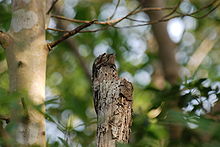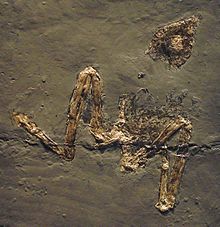- Potoo
-
Potoos 
Northern Potoo Scientific classification Kingdom: Animalia Phylum: Chordata Class: Aves Order: Caprimulgiformes Family: Nyctibiidae
Bonaparte, 1853Genus: Nyctibius
Vieillot, 1816Species See text.

Global range (In red) The potoos are a family, Nyctibiidae of near passerine birds related to the nightjars and frogmouths. They are sometimes called Poor-me-ones, after their haunting calls. There are seven species in one genus, Nyctibius, in tropical Central and South America.
These are nocturnal insectivores which lack the bristles around the mouth found in the true nightjars. They hunt from a perch like a shrike or flycatcher. During the day they perch upright on tree stumps, camouflaged to look like part of the stump. The single spotted egg is laid directly on the top of a stump.
Contents
Evolution and taxonomy
The potoos are today an exclusively New World family, but they apparently had a much more widespread distribution in the past. Fossil remains of potoos dating from the Oligocene and Eocene have been found in France and Germany.[1] A complete skeleton of the genus Paraprefica has been found in Messel, Germany. It had skull and leg features similar to those of modern potoos, suggesting that it may be an early close relative of the modern potoos. Because the only fossils other than these ancient ones that have been found are recent ones of extant species, it is unknown if the family once had a global distribution which has contracted or if the distribution of the family was originally restricted to the Old World and has shifted to the New World.
A 1996 study of the mitochondrial DNA of the potoos supported the monophyly of the family although it did not support the previous assumption that it was closely related to the oilbirds.[2] The study also found a great deal of genetic divergence between the species, suggesting that these species are themselves very old. The level of divergence is the highest of any genera of birds and is more typical of the divergence between genera or even families. This raises the possibility that there are several cryptic species to be discovered. For example the Northern Potoo was for a long time considered to be the same species as the Common Potoo, but the two species have now been separated on the basis of their calls. In spite of this there is no morphological way to separate the two species.[3]
Morphology
The potoos are a highly conservative family in appearance, with all the species closely resembling one another, and even species accounts in ornithological literature remark on the unusualness of their appearance.[3] Potoos range from 21–58 cm in length. They resemble upright sitting nightjars, a group they are closely related to. They also resemble the frogmouths of Australasia, but are stockier and have much heavier bills. They have proportionally large heads for their body size and long wings and tails. The large head is dominated by a massive broad bill and enormous eyes. In the treatment of the family in the Handbook of the Birds of the World, Cohn-Haft describes the potoos as little more than a flying mouth and eyes.[3] The bill, while large and broad, is also short, barely projecting past the face. It is also delicate, but has a unique "tooth" on the cutting edge of the upper mandible that may serve a function in foraging. Unlike the closely related nightjars the potoos lack rictal bristles around the mouth. The legs and feet are weak and used for perching only.
The eyes are large, even larger than those of related nightbirds in the order Caprimulgiformes. As in many species of nocturnal birds, they reflect the light of torches.[4] These eyes, which could be conspicuous to potential predators during the day, have unusual slits in the lids.[5] The slits allow potoos to sense movement even when their eyes are completely closed. The plumage of potoos is cryptic and designed to help them blend into the branches on which they spend their days.
Habitat and distribution
The potoos have a Neotropical distribution.[3] They range from Mexico to Argentina, with the greatest diversity occurring in the Amazon Basin, which holds five species. They are found in every Central and South American country except Chile. They also occur on three Caribbean islands: Jamaica, Hispaniola and Tobago. The potoos are generally highly sedentary, although there are occasional reports of vagrants, particularly species that have travelled on ships. All species occur in humid forests, although a few species also occur in drier forests.
Behaviour
 Lesser Potoo camouflaged on a stump
Lesser Potoo camouflaged on a stump
The potoos are highly nocturnal and generally will not fly during the day. They spend the day perched on branches with the eyes half closed. With their cryptic plumage they resemble stumps, and should they detect potential danger they will adopt a "freeze" position which even more closely resembles a broken branch.[6] The transition between perching and the freeze position is gradual and hardly perceptible to the observer.
Potoos feed at dusk and at night on flying insects.[3] Their typical foraging technique is to perch on a branch and occasionally fly out in the manner of a flycatcher[disambiguation needed
 ] in order to snatch a passing insect. They will occasionally fly to vegetation to glean an insect off it before returning to their perch, but they will not attempt to obtain prey from the ground. Beetles form a large part of their diet, but they will also take moths, grasshoppers and termites. One Northern Potoo was found with a small bird in its stomach as well. Having caught an insect potoos will swallow it whole without beating or crushing it.
] in order to snatch a passing insect. They will occasionally fly to vegetation to glean an insect off it before returning to their perch, but they will not attempt to obtain prey from the ground. Beetles form a large part of their diet, but they will also take moths, grasshoppers and termites. One Northern Potoo was found with a small bird in its stomach as well. Having caught an insect potoos will swallow it whole without beating or crushing it.Potoos are monogamous breeders and both parents share responsibilities for incubating the egg and raising the chick. The family does not construct a nest of any kind, instead laying the single egg on a depression in a branch or at the top of a rotten stump. The egg is white with purple-brown spots. One parent, often the male, incubates the egg during the day, then the duties are shared during the night. Changeovers to relieve incubating parents and feed chicks are infrequent in order to minimise attention to the nest, as potoos are entirely reliant on camouflage to protect themselves and their nesting site from predators. The chick will hatch about one month after laying and the nestling phase is two month, a considerable length of time for a landbird. The plumage of nestling potoos is white and once they are too large to hide under their parents they will adopt the same freeze position as their parents, and resemble a clump of fungus.
Species
- Great Potoo, Nyctibius grandis
- Long-tailed Potoo, Nyctibius aethereus
- Northern Potoo, Nyctibius jamaicensis
- Andean Potoo, Nyctibius maculosus
- Common Potoo or Lesser Potoo, Nyctibius griseus
- White-winged Potoo, Nyctibius leucopterus
- Rufous Potoo, Nyctibius bracteatus
References
- ^ Mayr, G (2005) "The Palaeogene Old World Potoo Paraprefica Mayr, 1999 (Aves, Nyctibiidae): its osteology and affinities to the New World Preficinae Olson, 1987" Journal of Systematic Palaeontology. 3 (4): 359–370 doi:10.1017/S1477201905001653
- ^ Mariaux, Jean & Braun, Michael J. (1996): A Molecular Phylogenetic Survey of the Nightjars and Allies (Caprimulgiformes) with Special Emphasis on the Potoos (Nyctibiidae). Molecular Phylogenetics and Evolution 6(2): 228–244. doi:10.1006/mpev.1996.0073
- ^ a b c d e Cohn-Haft, M (1999) "Family Nyctibiidae (Potoos)". in del Hoyo, J.; Elliot, A. & Sargatal, J. (editors). (1999). Handbook of the Birds of the World. Volume 5: Barn-Owls to Hummingbirds. Lynx Edicions. P.p. 288-297 ISBN 8487334253
- ^ Van Rossem, A (1927) "Eye Shine in Birds, with Notes on the Feeding Habits of Some Goatsuckers". The Condor 29 (1) 25-28
- ^ Borrero, J (1974) "Notes on the Structure of the Upper Eyelid of Potoos (Nyctibius)". The Condor 76 (2): 210-211
- ^ Perry, D (1979) "The Great Potoo in Costa Rica". The Condor 81 (3): 320-321
External links
- Potoo videos on the Internet Bird Collection
Categories:- Nyctibius
- Bird families
- Genera of birds
Wikimedia Foundation. 2010.

